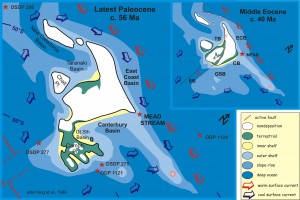GNS Science: If you lived in New Zealand 50 million years ago, you would have been able to enjoy a hot swim in the sea all year round, scientists have found.

The early Eocene, around 50 million years ago, has long been recognised as a time of pronounced global warming. New Zealand was vastly different then, with a larger landmass, a different shape, and covered in lush forest.
In a study published today in the international scientific journal Geology, scientists have established that New Zealand experienced fully tropical climatic conditions during this time period. The findings support evidence for tropical conditions in New Zealand’s fossil record but provide the first evidence for the true extent of tropical warmth in high southern latitudes.
Registered journalists can log-in to download the paper.
A group led by paleontologist Chris Hollis, of GNS Science, used three independent geochemical methods for extracting sea temperatures from sedimentary rocks exposed in the bed of the Waipara River in North Canterbury.
The SMC’s Dacia Herbulock interviews paper co-author, Chris Hollis.
[audio:https://www.sciencemediacentre.co.nz/wp-content/upload/2009/01/chris-hollis-interview.mp3]Chris Hollis presents his research at a conference on climate events of the Paleogene earlier this month.
[audio:https://www.sciencemediacentre.co.nz/wp-content/upload/2009/01/chris-hollis-the-eocene.mp3]
They have determined that surface sea waters exceeded 30°C and water at the sea floor hovered around 20°C during what they believe is a 2-3 million year episode of greenhouse gas-induced global warming.
” These temperatures are at the extreme end of modern tropical watermasses,” Dr Hollis said. Annual sea surface temperatures of 25-30 °C are restricted to equatorial regions today.
Tropical temperatures at this high latitude location (55°S in the Eocene) presented a huge challenge for climate modellers, Dr Hollis said.
Even under extreme greenhouse conditions of more than 2000 parts per million of carbon dioxide, computer models say New Zealand sea temperatures during the Eocene did not exceed 20°C.
” Anomalously warm conditions had also been reported for early Eocene records from high latitude regions in the Northern Hemisphere,” Dr Hollis said.
” It now seems likely that some, as yet unknown, heat transport mechanism comes into play during times of extreme global warmth.”
Co-author Matt Huber, of Purdue University, Indiana USA, said the new findings were at least 10 degrees warmer than scientists had previously thought.
“It suggests that existing temperature reconstructions for this period have been biased toward overly cold values,” Dr Huber said.
” It also indicates that climate models tend to under-estimate temperatures during past climate warming episodes. It is possible that models are also under-estimating future warming projections.”
Dr Hollis said further research into the causes of extreme climatic changes in New Zealand’s geological past would benefit from New Zealand’s recent decision to join the Integrated Ocean Drilling Program – an international geoscience programme that operates a drilling ship that can recover sediment cores up to 2000 m in length from beneath the ocean floor. The ship will be conducting a research leg off the coast of Canterbury in November 2009. – GNS Science